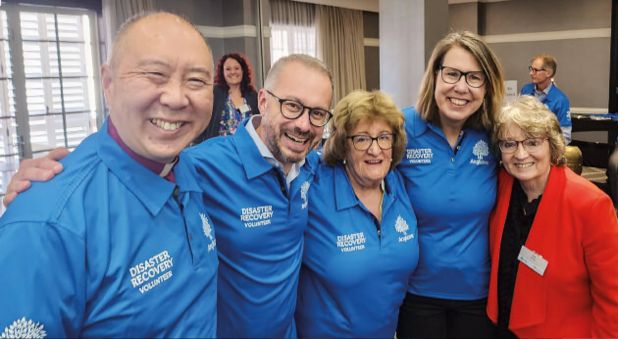The one thing we seem able to predict about modern weather patterns is their unpredictability, so it’s clear that, as a society, we need to be prepared – not just for bushfires, floods and other crises, but for supporting those affected by them.
And although some seasons carry more potential danger than others, we never know what’s around the corner.
Magnus Linder, Anglicare Sydney’s head of disaster recovery, says frankly that “NSW has gotten off very, very lightly [this summer]. It’s been very hot, no doubt about that, but the rain caught everyone by surprise.
“We started off with both fires and floods on the far South Coast at the beginning of the season, but then while Queensland, Western Australia and Victoria copped it in various ways – floods, cyclones, heatwaves and uncontrolled bushfires – NSW just had localised flooding in various areas. So, our volunteers were called to some incidents, but nothing large.
“We’re very thankful for that. But we’re still wondering what comes next, because the river systems are very full – Warragamba Dam is 97 per cent, and people who live near there know they are one good rain away from a flood event.”
This might seem unnecessarily downbeat, but Mr Linder and the team that trains and manages Anglicare’s 750 disaster recovery (DR) volunteers know they need to be ready for anything, at a moment’s notice.
Heather Gwilliam is team leader for the Nepean, which covers the Penrith, Blue Mountains, Hawkesbury and Lithgow areas. Since she took on the role 11 years ago, she has been involved with 12 disasters – mostly local, but including towns as far away as Moree in the state’s north and Batemans Bay on the South Coast.
“It’s the thing you volunteer to do in the hope that it’s never needed,” she says thoughtfully. “But the reality these days with climate change is we will be.”
Last year marked 25 years since Anglicare began offering DR services. It was also the organisation’s most successful recruiting year, with 100 men and women (including the Bishop of the Western Region, Gary Koo) trained to step in and care for people during a disaster.
Having said that, Mrs Gwilliam says “most teams could double or triple their size and still have need for more”. There are 76 people on her team but not everyone is able to come and help each time they’re asked, “so I could easily use another 30 to 40”.
This is partly because, at the height of a disaster, evacuation centres are open 24 hours a day and it doesn’t take long to churn through dozens of volunteers. There is also the need to provide help at post-crisis recovery centres after evacuation centres close.
“Every disaster is different – there’s no formula for how you do it,” Mrs Gwilliam says. “It’s all about care and concern for people in need, and that’s what you’re there for.
“I joined when I was in my late 40s. I wasn’t that active, but I knew about it and I was trained. You can’t come and help if you haven’t done the training... so even if you can’t commit to volunteering, get trained and get associated with a team so that when the time comes, you’ll be ready.”
Mr Linder says the teams that work best are those able to find jobs for people with different gifts – from pastoral care, to training and mentoring, to arranging shopping vouchers or setting up a short-term op shop.
“The majority of our volunteers are committed Christians, but I’ve been encouraging our teams, pastors we’ve talked to and team leaders to invite their friends, neighbours and colleagues – who might not darken the doorway of a church – to come and volunteer with us,” he says.
“I think that’s a very cool ministry in itself. They don’t have to be a believer or an attender at any church, but they need to respect [Anglicare’s] mission and values. We always pray together and talk about the work we’re doing from our Christian perspective... so if they join one of our teams, they’re going to have a dozen Christian friends, just like that!”
Anglicare’s DR training involves two short modules, offered online. For details, see [url=https://www.anglicare.org.au/disaster-recovery/]https://www.anglicare.org.au/disaster-recovery/[/url]
Photo:
Bishop Gary Koo, Anglicare CEO Simon Miller, Heather Gwilliam, Anglicare’s first DR manager Jenni Sawyer and Anglicare’s director of advocacy, Susan King.

















